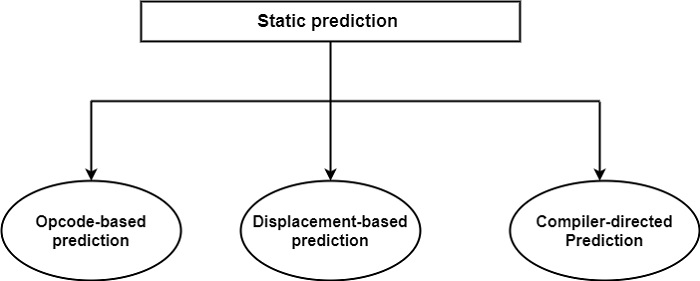
 Data Structure
Data Structure Networking
Networking RDBMS
RDBMS Operating System
Operating System Java
Java MS Excel
MS Excel iOS
iOS HTML
HTML CSS
CSS Android
Android Python
Python C Programming
C Programming C++
C++ C#
C# MongoDB
MongoDB MySQL
MySQL Javascript
Javascript PHP
PHP
- Selected Reading
- UPSC IAS Exams Notes
- Developer's Best Practices
- Questions and Answers
- Effective Resume Writing
- HR Interview Questions
- Computer Glossary
- Who is Who
What is Static Prediction?
In a static prediction technique, the branch is ‘always taken’ or the branch is ‘always not-taken’ approaches. It can make static predictions by investigating particular attributes of the object code. In actual implementation, static predictions are either opcode-based, displacement-based, or based on a hint delivered by the compiler, as shown in the figure.

Opcode-based predictions are made by assuming that the branch will be ‘taken’ for certain opcodes and ‘not taken’ for others. This prediction technique is used, for instance, in the MC 88110 and PowerPC 601/603 processors. As shown in the table, shows how opcode-based prediction is accomplished in the MC 88110 (Motorola, 1991).
Static prediction as implemented in the MC 88110 (1993)
| Instructions | |||
|---|---|---|---|
| Condition Specified | Bit 21 of the instr.code | Prediction | |
| = 0 | 0 | Not Taken | |
| ≠0 | 1 | Taken | |
| Bcnd (Branch Conditional) | >0 | 1 | Taken |
| <0 | 0 | Not Taken | |
| ≥0 | 1 | Taken | |
| ≤0 | 0 | Not Taken | |
| bb1 (Branch on bit set) | Taken | ||
| bb0 (Branch on bit clear) | Not Taken | ||
This processor offers two kinds of conditional branches. The first called bcnd is used for arithmetic checks. The second called either bb1 (Branch on bit set) or bb0 (Branch on bit clear), is for Boolean checks. As shown in the table, for arithmetic checks the condition ≠0,>and ≥0 are assumed to be met and thus the prediction is ‘taken’. In contrast, the conditions =0,<0,and ≤0 give rise to a ‘not taken‘prediction, and bit 21 is reset.
Displacement-based predictions depend on the sign of the displacement. If D < 0, the prediction is ‘taken’, in the opposite case, D≥0, it is ‘not taken’. Here the underlying assumption is that a conditional branch with negative displacement is used as a loop-closing branch.
Finally, a static prediction can also be derived from a hint from the compiler. This kind of prediction is called compiler-directed prediction. In this case, the compiler predicts according to the kind of control construct compiled or user-delivered hint. The compiler’s prediction is indicated by setting or clearing a bit (called the predict bit) in the encoding of the conditional branch instruction.
For instance, in the PowerPC architecture bit, 10 of the encoding of conditional branches is the predict bit. When specified as such, the outcome of opcode-based and displacement-based prediction is reversed. Examples of processors using predict bits are the PowerPC 601 and PowerPC 603.
Another processor which makes use of compiler-directed predictions is the PA 8000. In this case, a compiler-directed prediction is an available option. If specified, it over-rules dynamic prediction on a page-by-page basis.
This remarkable solution enables the use of static prediction in programs recompiled for the PA 8000 if a higher predicated rate can be expected. On the other hand, older programs like library routines can carry on using dynamic prediction as to the default prediction method.

